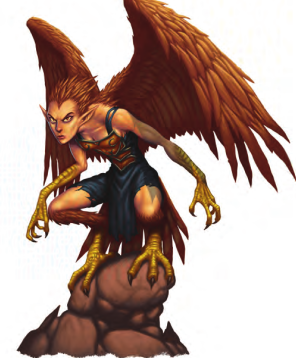Let's Read the 4e Monster Manual/Vault: Harpy

This article is part of a series! Click here to see the other entries.
D&D Harpies are inspired by the harpies from Greek mythology, with a bit of siren mixed in. They’ve been in the game since pretty much the beginning. Here, they are on the Monster Manual only.
The Lore
In ancient times there was an evil elf witch queen. She and her unscrupulous children often took the form of golden eagles to spy on their subjects. A mighty hero defeated them and drove them into exile, breaking the queen’s magic crown in the process. It was the crown that gave them the power to change shape, and when it broke the evil family became stuck as part-bird, part-elf beings. These were the first harpies.
Modern harpies roost in dismal places where few others can live: swamps, badlands, ruins, coastal cliffs. They fly out to hunt or to attack travelers, pacifying their victims with their magic-imbued songs and tearing them apart with their claws.
Both male and female harpies exist, but they usually only spend enough time together to produce a batch of eggs. Once the female lays her eggs, the male takes off. Because of this is quite rare for PCs to find a mixed-gender group of harpies.
The Numbers
Harpies are Medium Fey Humanoids and have human-level intelligence. This means there’s nothing stopping your setting from containing settlements of unaligned or friendly harpies, but the ones we get here are Evil bandit-types.
Harpies walk with speed 6 and fly with speed 8 (clumsy), which means they mostly fight on the ground when using their claws, or from some high perch when using their ranged special powers. If you want them to be better fliers, removing the Clumsy keyword is a good start.
Unlike the elves they used to be, harpies have no special ability to see in the dark.
Harpy
The classic model is a Level 6 Controller with 71 HP and the common traits listed above. It also has Resist 10 Thunder.
Harpies fight in melee with their claws, and prefer to do so from the ground since they’re clumsy fliers.
Their main special ability is the afore-mentioned Alluring Song (Close Burst 10 vs. Will), which can affect any non-deaf enemy in range. A hit pulls the target 3 squares and immobilizes them (save ends). The harpy can use a minor action in subsequent turns to sustain the power and pull anyone who hasn’t saved yet another 3 squares.
Once their enemies are all nice and bunched up, the harpy can let loose a Deadly Screech (Close Burst 4 vs. Fortitude; recharge 5-6), which does thunder damage and dazes (save ends).
Both of the harpy’s damaging attacks are in serious need of a damage boost. This, and removing the Clumsy keyword from their flight speed, should be enough to bring them up to MV standards. The Alluring Song is particularly dangerous in a battlefield full of cliffs or other hazards.
Bloodfire Harpy
This one doesn’t bother with nice songs, it just kills you with fire.
A Bloodfire Harpy is a Level 9 Soldier with 100 HP. It has Resist 10 Fire and sings a Burning Song (aura 20) that slowly boils the blood of anyone in range who can hear it, dealing 5 fire damage at the start of their turns.
This harpy also fights with claws, which are red-hot and do a mix of physical and fire damage. It can also disgorge a Cloud of Ash (Close Blast 3 vs. Fortitude; recharge 4-6) which does fire damage and blinds (save ends).
These fiery things could use the same damage boost as the basic model, but they work fine otherwise.
Sample Encounters and Final Impressions
Judging by the sample encounters in the book, harpies tend to keep some fine company:
-
Level 6: 3 harpies, 2 spined devils. They have a lot in common when you think about it.
-
Level 8: 1 bloodfire harpy, 3 gnoll marauders, 2 cacklefiend hyenas. Just a bunch of bros hanging out, doing some light pillaging and burning.
-
Level 8: 2 harpies, 1 sahuagin priest, 3 sahuagin raiders. Better plug your crew’s ears before you get too close to this reef.
I like harpies! Mythological monsters are always fun, and these ones have some interesting song effects. It’s also not too hard to come up with new varieties, like a skirmisher harpy with better agility and Flyby Attack, or one that can put people to sleep with their song.